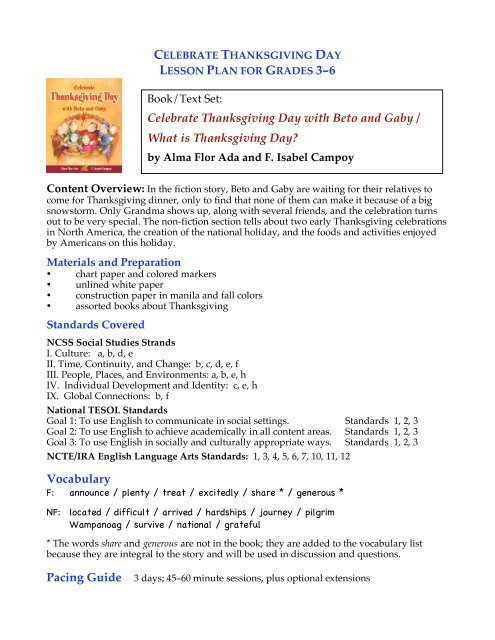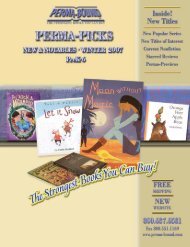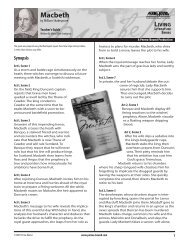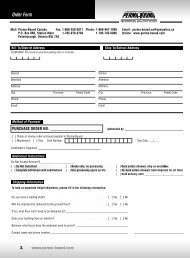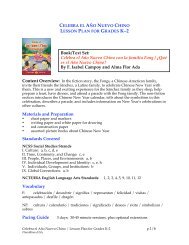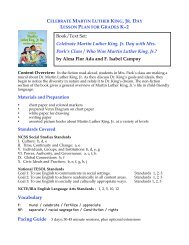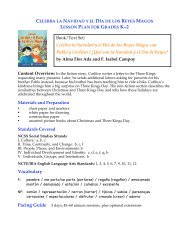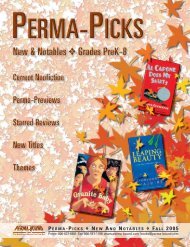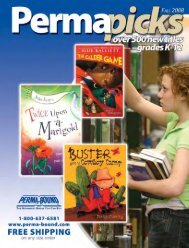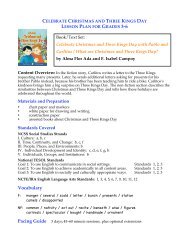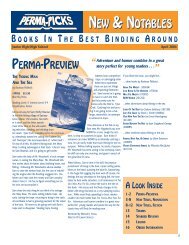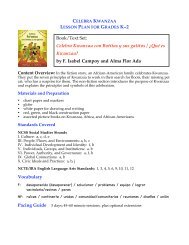Vocabulary Celebrate Thanksgiving Day with Beto ... - Perma-Bound
Vocabulary Celebrate Thanksgiving Day with Beto ... - Perma-Bound
Vocabulary Celebrate Thanksgiving Day with Beto ... - Perma-Bound
Create successful ePaper yourself
Turn your PDF publications into a flip-book with our unique Google optimized e-Paper software.
CELEBRATE THANKSGIVING DAYLESSON PLAN FOR GRADES 3–6Book/Text Set:<strong>Celebrate</strong> <strong>Thanksgiving</strong> <strong>Day</strong> <strong>with</strong> <strong>Beto</strong> and Gaby /What is <strong>Thanksgiving</strong> <strong>Day</strong>?by Alma Flor Ada and F. Isabel CampoyContent Overview: In the fiction story, <strong>Beto</strong> and Gaby are waiting for their relatives tocome for <strong>Thanksgiving</strong> dinner, only to find that none of them can make it because of a bigsnowstorm. Only Grandma shows up, along <strong>with</strong> several friends, and the celebration turnsout to be very special. The non-fiction section tells about two early <strong>Thanksgiving</strong> celebrationsin North America, the creation of the national holiday, and the foods and activities enjoyedby Americans on this holiday.Materials and Preparation• chart paper and colored markers• unlined white paper• construction paper in manila and fall colors• assorted books about <strong>Thanksgiving</strong>Standards CoveredNCSS Social Studies StrandsI. Culture: a, b, d, eII. Time, Continuity, and Change: b, c, d, e, fIII. People, Places, and Environments: a, b, e, hIV. Individual Development and Identity: c, e, hIX. Global Connections: b, fNational TESOL StandardsGoal 1: To use English to communicate in social settings. Standards 1, 2, 3Goal 2: To use English to achieve academically in all content areas. Standards 1, 2, 3Goal 3: To use English in socially and culturally appropriate ways. Standards 1, 2, 3NCTE/IRA English Language Arts Standards: 1, 3, 4, 5, 6, 7, 10, 11, 12<strong>Vocabulary</strong>F: announce / plenty / treat / excitedly / share * / generous *NF: located / difficult / arrived / hardships / journey / pilgrimWampanoag / survive / national / grateful* The words share and generous are not in the book; they are added to the vocabulary listbecause they are integral to the story and will be used in discussion and questions.Pacing Guide3 days; 45–60 minute sessions, plus optional extensions
Reading and ActivitiesDAY 1Explore the Topic: <strong>Thanksgiving</strong> <strong>Day</strong> / GenerosityStart a discussion about what it means to be generous. Have students give examples of timesthey have shared things. After several students have responded, tell them you’re going toread a <strong>Thanksgiving</strong> story about a generous family.<strong>Vocabulary</strong> IntroductionAt the top of a piece of chart paper, write “<strong>Thanksgiving</strong>,” and then list the vocabularywords for the fiction section in a column. Then add the words “share” and “generous.” Readthe words <strong>with</strong> students and ask for volunteers to give definitions or use them in sentences.As students respond, add to their responses as necessary to give a clear definition of eachword.Fiction Read-Aloud & DiscussionOn a piece of chart paper, write, “<strong>Thanksgiving</strong>: Facts We Know.” Have students tell whatthey know about <strong>Thanksgiving</strong>, and write their responses on the chart. Review all responses<strong>with</strong> students and leave the chart on display.In this session you will read aloud only the fiction story, <strong>Celebrate</strong> <strong>Thanksgiving</strong> <strong>Day</strong> <strong>with</strong> <strong>Beto</strong>and Gaby. Before reading the story, show the cover and have a volunteer read the title aloud.Have students infer who the people on the cover are.As you read, stop to have students use context to define unfamiliar words. Ask students tolisten for acts of generosity, and make note of the growing number of guests being invited byGrandma.When the story is finished, ask students to recall the generous acts in the story sequentiallyand to tell how these acts might affect the larger community (beyond the family itself). Askthe following questions, using the illustrations in the book whenever appropriate to helpstudents <strong>with</strong> their responses:BeginningIntermediateAdvanced1. Where is Grandma?2. What did the mother share <strong>with</strong> the neighbors?3. Who came to <strong>Beto</strong> and Gaby’s house <strong>with</strong> Grandma?1. Why is Grandma on a bus? Where is she going?2. Why did the mother share food <strong>with</strong> the neighbors?3. Why did Grandma bring so many people <strong>with</strong> her to<strong>Thanksgiving</strong> dinner? What else did Grandma bring?1. Tell about the telephone calls <strong>Beto</strong> and Gaby’s family received.2. Name someone in the story who is generous and explain what thisperson does that shows his or her generosity.3. Describe what you think the family is going to eat for<strong>Thanksgiving</strong> dinner.<strong>Celebrate</strong> <strong>Thanksgiving</strong> <strong>Day</strong> / Lesson Plan for Grades 3-6©Santillana USAp.2/6
Intermediate 1. Where did the Pilgrims have a <strong>Thanksgiving</strong> dinner, and whodid they invite?2. What did Oñate and his people celebrate at their <strong>Thanksgiving</strong>party?3. What are some ways that people share at <strong>Thanksgiving</strong>?Advanced 1. Explain the ways in which the Wampanoags helped thePilgrims survive.2. Tell about Oñate’s trip and <strong>Thanksgiving</strong> celebration.3. What do you think is the most important part of <strong>Thanksgiving</strong>,and why?After discussion, review the Facts chart to analyze the statements for accuracy and conflict<strong>with</strong> information from the story. If statements on the chart conflict <strong>with</strong> factual information,elicit a discussion <strong>with</strong> students using readings of short passages of the text. Add to the titleof this chart by crossing out “Facts We Know” and inserting “What We Knew and Thought.”To the right of the Questions chart, post another piece of chart paper so that all three chartsare posted in sequence. At the top of the new piece of chart paper, write “<strong>Thanksgiving</strong>:Answers We Found” and ask students to identify any questions that may have beenanswered during the reading. Color code the questions and answers by writing the answersdirectly across from each question using the same color marker as was used for that question.When finished, leave any unanswered question spaces blank.Post a fourth piece of chart paper in line <strong>with</strong> the others. At the top, write “<strong>Thanksgiving</strong>:Facts We Didn’t Know.” Ask students to write on this chart any <strong>Thanksgiving</strong> informationthat is completely new to them. Be sure to remind students that some information may benew to some students and known to others, but if the information is new to anyone, it can goonto the chart.When finished <strong>with</strong> this chart, ask students to review each item and to formulate a questionthat can be answered by each fact.DAY 3<strong>Vocabulary</strong> ReviewHave students work <strong>with</strong> the <strong>Thanksgiving</strong> Facts worksheet. As students finish, allow sometime to browse and read additional books about <strong>Thanksgiving</strong> and add new information tothe charts. As a whole group, review all the charts and add any new information whereappropriate. If more questions have been answered, have students refer to the books wherethey found the answers and show the pages to the class.Writing ActivityTell students that they will work together to write collaborative Question and Answer Bookscalled Facts About <strong>Thanksgiving</strong> and that each person will write one page. Further explain thateach page will have the question on the front and the answer on the back so that the reader<strong>Celebrate</strong> <strong>Thanksgiving</strong> <strong>Day</strong> / Lesson Plan for Grades 3-6©Santillana USAp.4/6
will need to turn the page to get the answer. Write the directions on the board:1. Write the question on one paper.2. Write the answer on another paper and illustrate.3. Check spelling and trace over the words <strong>with</strong> a black marker.4. Cut the papers in an interesting shape.5. Glue the papers on the front and back of a sheet of construction paper.Read the directions <strong>with</strong> students and show a couple of model pages to make sure theyunderstand what they are to do. To prepare for the writing, review the vocabulary list. Letstudents know that you can write any other words they need on the board after they begin towrite. Review all the charts too, and talk about questions and answers. Review what thequestions might have been for the “Facts We Didn’t Know” chart.Assign information for the pages to students. Some students may use chartedquestion/answer pairs, while others may need to create questions to go <strong>with</strong> charted facts.For younger or beginning students, the question/answer pairs can be cut up into strips andtaken to students’ desks for easier copying. Some question/answer pairs may be assigned totwo students so that at least two books are created. More research may also be done to findadditional information.Compile all finished pages in an order that preserves continuity and bind into two or morebooks. For more durability, laminate all the pages before binding. Read the finished booksaloud to the class and add them to the classroom library.ExtensionsWritingArtMusicMathematicsRead Shel Silverstein’s poem “Point of View” from his book Where theSidewalk Ends. Discuss the poem and then write a poem or story about<strong>Thanksgiving</strong> from the turkey’s point of view. Illustrate your writing.Make a classroom mural showing examples of generosity. Use a variety ofstudent-drawn illustrations and writing, magazine pictures <strong>with</strong> captions,newspaper articles, and any other appropriate sources.Learn the songs, "My Favorite Things" by Rodgers & Hammerstein and"Things I'm Thankful For" by Hap Palmer. Lyrics and music for both songscan be found online at the following sites:My Favorite Things:http://www.niehs.nih.gov/kids/lyrics/favorite.htmThings I'm Thankful For:http://www.songsforteaching.com/happalmer/thingsimthankfulfor.htmUse newspaper grocery ads to “shop” for <strong>Thanksgiving</strong> dinner. Workingin groups, plan a healthy, balanced menu. Create a chart listing the fooditems and prices. Calculate the amount it would cost to feed one family,ten families, twenty families.<strong>Celebrate</strong> <strong>Thanksgiving</strong> <strong>Day</strong> / Lesson Plan for Grades 3-6©Santillana USAp.5/6


